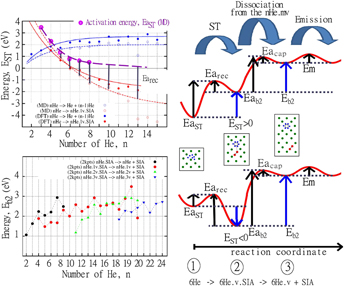Crossref Citations
This article has been cited by the following publications. This list is generated based on data provided by
Crossref.
Richter, Asta
Anwand, Wolfgang
Chen, Chun-Liang
and
Böttger, Roman
2017.
Evaluation of defect formation in helium irradiated Y2O3 doped W-Ti alloys by positron annihilation and nanoindentation.
Journal of Nuclear Materials,
Vol. 494,
Issue. ,
p.
294.
Kong, Fanhang
Qu, Miao
Yan, Sha
Zhang, Ailin
Peng, Shixiang
Xue, Jianming
and
Wang, Yugang
2017.
Helium-induced hardening effect in polycrystalline tungsten.
Nuclear Instruments and Methods in Physics Research Section B: Beam Interactions with Materials and Atoms,
Vol. 406,
Issue. ,
p.
643.
Hammond, Karl D
2017.
Helium, hydrogen, and fuzz in plasma-facing materials.
Materials Research Express,
Vol. 4,
Issue. 10,
p.
104002.
Perez, Danny
Sandoval, Luis
Blondel, Sophie
Wirth, Brian D.
Uberuaga, Blas P.
and
Voter, Arthur F.
2017.
The mobility of small vacancy/helium complexes in tungsten and its impact on retention in fusion-relevant conditions.
Scientific Reports,
Vol. 7,
Issue. 1,
Yang, Zhangcan
Blondel, Sophie
Hammond, Karl D.
and
Wirth, Brian D.
2017.
Kinetic Monte Carlo Simulations of Helium Cluster Nucleation in Tungsten with Preexisting Vacancies.
Fusion Science and Technology,
Vol. 71,
Issue. 1,
p.
60.
Marian, Jaime
Becquart, Charlotte S.
Domain, Christophe
Dudarev, Sergei L.
Gilbert, Mark R.
Kurtz, Richard J.
Mason, Daniel R.
Nordlund, Kai
Sand, Andrea E.
Snead, Lance L.
Suzudo, Tomoaki
and
Wirth, Brian D.
2017.
Recent advances in modeling and simulation of the exposure and response of tungsten to fusion energy conditions.
Nuclear Fusion,
Vol. 57,
Issue. 9,
p.
092008.
De Backer, A.
Mason, D.R.
Domain, C.
Nguyen-Manh, D.
Marinica, M.-C.
Ventelon, L.
Becquart, C.S.
and
Dudarev, S.L.
2018.
Multiscale modelling of the interaction of hydrogen with interstitial defects and dislocations in BCC tungsten.
Nuclear Fusion,
Vol. 58,
Issue. 1,
p.
016006.
Sandoval, Luis
Perez, Danny
Uberuaga, Blas P.
and
Voter, Arthur F.
2018.
Formation of helium-bubble networks in tungsten.
Acta Materialia,
Vol. 159,
Issue. ,
p.
46.
Domain, C.
and
Becquart, C.S.
2018.
Solute – 〈111〉 interstitial loop interaction in α-Fe: A DFT study.
Journal of Nuclear Materials,
Vol. 499,
Issue. ,
p.
582.
Unn-Toc, Wesley
Marinica, Mihai-Cosmin
and
Jourdan, Thomas
2018.
Helium–vacancy interactions in vanadium and tantalum.
Computational Materials Science,
Vol. 145,
Issue. ,
p.
197.
Yang, Zhuocen
Hu, Lin
Maroudas, Dimitrios
and
Hammond, Karl D.
2018.
Helium segregation and transport behavior near ⟨100⟩ and ⟨110⟩ symmetric tilt grain boundaries in tungsten.
Journal of Applied Physics,
Vol. 123,
Issue. 22,
Liu, Lu
Li, Shouzhe
Liu, Dongping
Benstetter, Günther
Man, Ondrej
Michalicka, Jan
Zhang, Yang
Hong, Yi
Fan, Hongyu
Ni, Weiyuan
Yang, Qi
Wu, Yunfeng
and
Bi, Zhenhua
2019.
The effect of O2 impurity on surface morphology of polycrystalline W during low-energy and high-flux He+ irradiation.
Fusion Engineering and Design,
Vol. 139,
Issue. ,
p.
96.
Rieth, Michael
Doerner, Russell
Hasegawa, Akira
Ueda, Yoshio
and
Wirtz, Marius
2019.
Behavior of tungsten under irradiation and plasma interaction.
Journal of Nuclear Materials,
Vol. 519,
Issue. ,
p.
334.
Sandoval, Luis
Perez, Danny
Uberuaga, Blas P.
and
Voter, Arthur F.
2019.
An Overview of Recent Standard and Accelerated Molecular Dynamics Simulations of Helium Behavior in Tungsten.
Materials,
Vol. 12,
Issue. 16,
p.
2500.
Zhao, Shangquan
Ran, Guang
Li, Fangbiao
Deng, Huiqiu
and
Gao, Fei
2019.
Ab initio study of interstitial helium clusters in 3C-SiC.
Journal of Nuclear Materials,
Vol. 521,
Issue. ,
p.
13.
Shah, V.
van Dommelen, J.A.W.
and
Geers, M.G.D.
2020.
Spatially dependent kinetics of helium in tungsten under fusion conditions.
Journal of Nuclear Materials,
Vol. 535,
Issue. ,
p.
152104.
Wang, Jinlong
Guo, Zhichao
Dang, Wenqiang
and
Liu, Daping
2020.
Molecular dynamics investigation of the configuration and shape of helium clusters in tungsten.
Nuclear Fusion,
Vol. 60,
Issue. 12,
p.
126015.
Gonzalez-Arrabal, R.
Rivera, A.
and
Perlado, J. M.
2020.
Limitations for tungsten as plasma facing material in the diverse scenarios of the European inertial confinement fusion facility HiPER: Current status and new approaches.
Matter and Radiation at Extremes,
Vol. 5,
Issue. 5,
Liao, Liang-Xiang
Zhang, Xun
Ren, Cui-Lan
Zhang, Zheng-De
Huang, He-Fei
Ma, Guo-Hong
and
Huai, Ping
2020.
First-principles study of helium behavior in nickel with noble gas incorporation.
Journal of Applied Physics,
Vol. 127,
Issue. 17,
Cusentino, M.A.
Wood, M.A.
and
Thompson, A.P.
2020.
Suppression of helium bubble nucleation in beryllium exposed tungsten surfaces.
Nuclear Fusion,
Vol. 60,
Issue. 12,
p.
126018.





